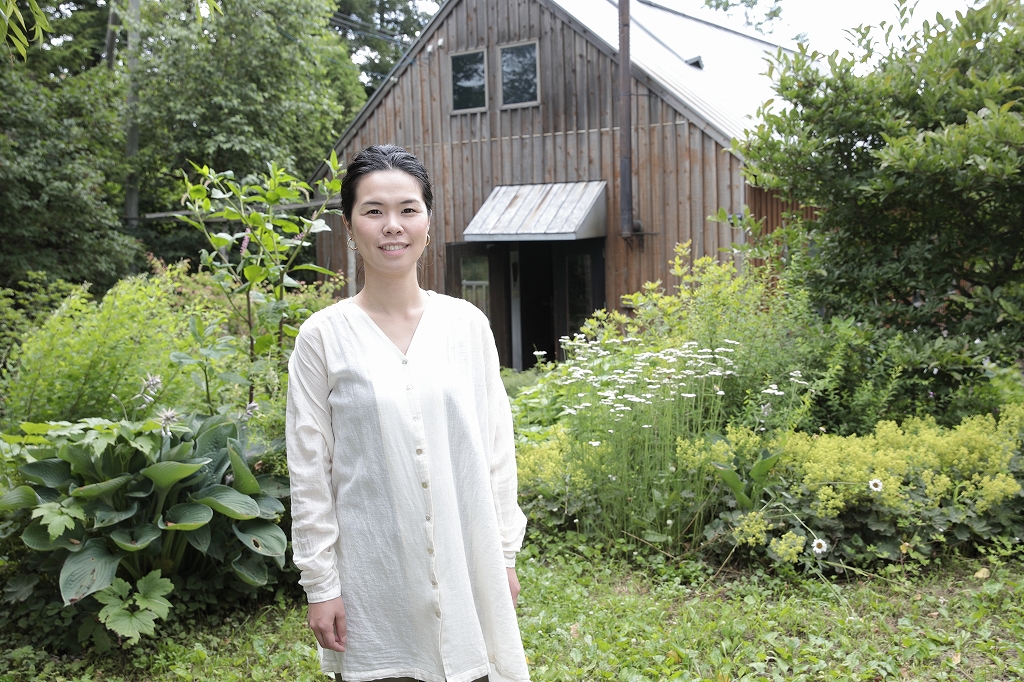
There are insects and some parts are withered, but that is also life
vol.19Nishiyama Yuki / Naganuma Town

Photographs by Ito Rumiko
Translation by Xene Inc.

I want to depict the vitality of weeds
Leaves that are withered or eaten by insects are mixed in with the beautiful flowers, something that Yuki, as a creator, is particular about. “It’s nature as it really is; I want to depict vitality.”
When we visited her workshop and saw the garden in which seeds seem to have rooted at will, it was easy to see the origin of Yuki’s artistic spirit. “When I observe the vegetation I’m aware of how interesting the veins of the leaves are, and how the colors look completely different according to the light. There are many things I wouldn’t know if it weren’t for this garden.”
Yuki’s father, Ryo is also a glass creator. “From when I was a child, everyday dishes and cups were items of art and craft. I was blessed to have such an environment,” recalls Yuki.

Bowl: the energy that makes weeds grow is fascinating

Bowl: an ant crawls above the flowers and leaves

Images of interesting vegetation and shapes that come to mind are sketched
An encounter with a certain gallery owner
The delicate artwork is a feature of Yuki’s work. Enamel pigment is used to color the sections of glass carved out by a sandblasting method, and added details are drawn by hand. The deciding factor for Yuki is the moment she knows what to draw on the transparent canvas.
“When I draw pictures on the outside and inside of the receptacle, the glass has a certain thickness that creates a mysterious 3-D effect with depth; that’s something interesting that cannot be expressed on paper.” That style was nurtured thanks to the owner of a gallery in Roppongi.
Four years ago, when she tried to sell her blown-glass work, Yuki was told in no uncertain terms that it was “completely useless!” But on seeing Yuki’s portfolio from when she was a student, the advice that was given made Yuki shed a tear. “Why don’t you try drawing pictures on the glass? Next year, we’ll put your work in an exhibition. You don’t have to worry about whether or not they sell; just enjoy it.” When Yuki was struggling to make it as a creator, that encounter was her shining light. When things are not going well it shows in the work, and it was then that Yuki learned that it is important to thoroughly enjoy what you do.

Bowl: an early piece from just after she started to decorate the glass

The workshop that Yuki shares with her father

Color samples to check the finished work

The intricate brushwork is quite demanding

Bowl: wild mountain grape design
The significance of working with glass in Hokkaido, sensed in Scandinavia
After studying general arts and crafts such as woodwork, metal casting, dyeing & weaving, metalwork, glass, ceramics and the like at a junior college in Akita, Yuki learned the fundaments of glassmaking techniques around the world directly from a master craftsman at the Toyama City Institute of Glass Art. After graduating, Yuki worked as an assistant of Takahashi Yoshihiko, a glass creator she admired since high-school age. She then went on to polish her basic skills while trying out various materials and methods at the Toyama Glass Studio.
Yuki returned to Hokkaido to think about the future, but then found herself heading to Scandinavia, after a friend suggested she take over as an assistant of Scandinavian glass creator Monica L Edmondson. The period was for one month only. Yuki didn’t hesitate, and soon found herself in a studio near Lapland, where the nature – with its great rivers and deep forests – was different to that of Hokkaido, and where Yuki experienced her first midnight sun. Looking back, Yuki was deeply impressed when Monica told her “My identity is inherited from the indigenous Sami people. I use patterns and colors that are handed down from the Sami, and creating glass crafts here in Lapland is meaningful”. Until then, Yuki had never been conscious of her identity and the like. Looking back, “it was probably the first time I realized the significance of working with glass in Hokkaido”.

This summer’s representative piece. The translucent dragonfly is beautiful

Decorate a space with flowers by just placing one of these mysterious vases somewhere

Nishiyama Yuki profile
1984 Born in Hokkaido
2004 Graduates from the Glass Course of The Akita Municipal Junior College of Arts and Crafts
2005 Studies at Pilchuck Glass School (Seattle. USA)
2006 Graduates from the Faculty of Art & Design, Toyama City Institute of Glass Art
2006 Assistant at the Takahashi Yoshihiko Glass Studio (Kanagawa Prefecture)
2007 Employed at the Toyama Glass Studio (until 2010)
2010 Work activities based in Hokkaido
2010 Works on the “Torinouta” overseas exchange project (Toyama Glass Studio Gallery), taking the exhibition to Singapore and the UK
2011 Becomes Monica L Edmondson’s assistant (Sweden)



